At least six times in the past six weeks, I started to write here and gave up. I was aware on some level that my inability to write reflected the ambivalence and lack of focus I’ve felt toward running since mid-May. Troubled by an injury flare-up in my foot and channeling most of my time into parenting and work, I reduced running to a minimum after the Miwok 100K and put this blog on hold. Every time I tried to contemplate the monster challenge looming in less than three months—the 168-mile, 7-day, self-supported Grand to Grand Ultra—I mentally blanked out and turned back to some task at hand, because I didn’t have the capacity to embrace that challenge.
A couple of things helped me focus: I ran a 50K race last Saturday—deciding just the day before to do it to get in the training miles no matter what—and a deadline for Trail Runner Magazine’s blog pushed me to organize the Grand to Grand training plan. (The article is reprinted below.) Mostly, though, I was jolted by a spot-on essay in last Sunday’s New York Times, The “Busy” Trap. I let myself fall back into this mostly self-imposed busy trap that we had escaped when our family traveled and lived a nomadic lifestyle in 2009-10. I let this blog go dormant not just because I prioritized spending time on other things, but because I’ve been in a too-busy mode that inhibits reflection and creativity.
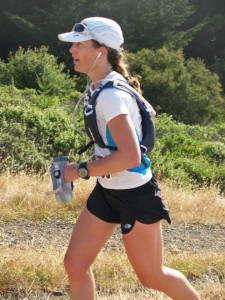
Cresting Cardiac Hill on the Dipsea during Inside Trail Racing's Marin Ultra Challenge 50K last Saturday. I was so glad I just got out and did it.
I can scarcely believe it’s July already. My daughter graduated from 8th grade and is heading to a boarding school (Thacher) at summer’s end, so the mom in me wants to drop everything and spend time with her. My poor son broke his ankle about two weeks ago, so the mom in me had to let other things go to handle his orthopedic care and figure out what he’s going to do for summer in his sedentary state. Morgan and I have a lot going on at Cogent Legal. He’s genuinely overly busy while managing the challenges of a new business. I feel like my primary job is and should be supporting Morgan, Colly and Kyle. But the obligations I took on don’t go away, so I try to do too many things and end up doing none of them very well or enjoyably. My cranky, amped-up personality overshadows time with my kids, and inwardly I berate myself for role modeling what I don’t want them to become. (Geez, lady, chill! OK.)
I don’t want running—my hobby, passion, source of good health and time to unplug—to add to that negative busyness, but running started to feel that way because of the training schedule necessitated by the Grand to Grand. I don’t have to do it, I remind myself. As explained in a previous post, the opportunity came out of the blue as an assignment. I still believe I made the right choice by saying “yes.” Now the challenge is to enjoy it! These months of training are part of the journey. Take it week by week and do the best I can, or at least good enough. Accept that I probably won’t have the time and energy to prepare as optimally as I could (as outlined in the bulleted list at the article’s end) because I don’t want to sacrifice that much time.
Thankfully, we built travel into the summer schedule. I’m eager to hit the road and return to the mountains. Recently, Morgan and I took a short trip to Jackson, Wyoming, as part of a conference, and early-morning trail runs in the Tetons, through forests of pine, cottonwood and aspen, rejuvenated my spirit and mellowed me out.
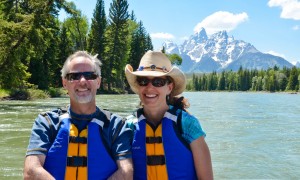
Morgan and me on the Snake River near Jackson. What I'll remember most from that scenic float is being on my cell phone trying to make an appointment with an orthopedist, since my son, at sleep-away camp, had just broken his ankle!
This week we’re driving to Telluride, Colorado, to spend time at my brother’s and be on hand for Hardrock. Funny thing is, I’m looking forward to the 1000-mile drive across the Southwest as much as the week in Telluride. I love when our family, plus the dog, is in the car together, just driving, the simplicity and togetherness of those hours contrasting with the complexity and separateness of our weekday lives at home.
Here is the article about the Grand to Grand training plan originally published on Trail Runner’s website. Re-reading it makes me psyched for the present as well as for the months ahead. I’m trying to escape the busy trap with a positive perspective, sense of humor and mindfulness. As John Lennon once said, “Life is what happens when you’re busy making other plans.”
Many thanks to my friend Meghan Hicks, who’s been a great source of training advice for stage racing prep. Here’s a photo of Meghan and me from last December, taken during a photo shoot for Trail Runner:
Training for a Self-Supported Stage Race
Training to run a multi-day ultra is one thing. Training to run a self-supported ultra over a week is something else entirely.
I’m preparing for a 168-mile, seven-day event in September, and I’m either confident or foolish enough to believe I can log enough back-to-back long runs over the next two months, toughen my mental resolve and unlock the keys to nutrition and hydration to go the distance. To date, I have run one 100K and a handful of 50-milers.
The prospect of carrying an adequate supply of food and gear, however, makes me question whether I’ll even make it through the first 50K leg. I rarely run long and hard on consecutive days, believing in tapers and recoveries. Backpacking? Not my thing. Give me a base camp from which I can depart on treks with a hand-held bottle and a few gels stuffed into tiny pockets, and I’m a happy trail runner.
So, what does it take to carry up to 20 pounds on your back while covering those miles, and what exactly do you bring along for the journey? That’s what I’m figuring out and will be sharing here to help anyone who might want to try stage racing or fastpacking.
I now need to condition my body and mind to run consecutive long days on challenging terrain while carrying a well-stocked pack, because on September 23, I plan to be on the North Rim of the Grand Canyon with some 70 other participants at the inaugural Grand to Grand Ultra (see previous post for event details). The race directors provide water, communal tents and salt tablets, but participants are on their own for food and gear.
We’ll cross remote desert and forest lands, climbing in and out of canyons on footing ranging from soft sand to rocky hard-pack, until we summit the pink cliffs of the Grand Staircase formation in the Escalante National Monument area of Southern Utah. The seven days are divided into six stages with the following mileages: 31, 28, 44, 24, 26 and 15. The elevation profile indicates a total ascent of nearly 22,000 feet and total descent of nearly 18,000 feet.
To start seriously training, I had to pick a pack. For advice and recommendations, I turned to an experienced stage racer, Trail Runner Contributing Editor Meghan Hicks, who carried her food and gear for a week all three times she raced the Marathon des Sables in the Sahara Desert of Morocco.
Choosing the right pack, she told me, should be an experiment of one. In other words, figure out what works for you, and no one else. To do so means practicing running with various models fully loaded.
Hicks said one member of a men’s team at the Marathon des Sables, for example, suffered mightily because he insisted on using the same pack as the rest of his team even though it wasn’t right for him. “There are horror stories about people whose backs rub off during these races,” Hicks said.
The pack’s fit, size, weight and hydration system are main factors to consider. Research led me to conclude I’d need a pack between 20 to 30 liters (L) in volume, with some combination of bottles on my hips, front or held by hand. I was advised to avoid using a bladder in the pack for water, because they’re difficult to fit into a stuffed pack and refill; plus, it’s hard to gauge how much you have left.
These packs look ridiculously small—about the size of my kids’ school backpacks—and can weigh less than a pound. But they’re enough to carry up to 20 pounds of food and gear, which is about the most I’ll want to carry on Day One. (The pack will lighten as the food supply is consumed.) Elite racers sacrifice comforts such as extra food, a sleeping pad and a camera to save several pounds.
I tried two packs: the Terra Nova Laser 20L and the Inov-8 Race Elite 25L, both weighing about 12 ounces. I liked the fit of the Terra Nova, but didn’t like its bottle-holder placement on the hips, where the bottles felt difficult to grab and bumped into my elbows.
Then a friend who’s done several 250K desert crossings with the Racing the Planet series turned me on to extra-large (750-milliliter) bottles with built-in straws that attach to the front of shoulder straps, on the chest. I ordered a couple of those holders from Inov-8 along with the bottles from RaidLight, and I added an Amphipod pocket attachment to the waist strap for extra carrying space.
I couldn’t stop laughing the first time I gave the tricked-out Inov-8 pack a try. First of all, it’s not exactly friendly to a woman’s anatomy. The bottles sit like mini rocket launchers on the sides of my breasts, which are squished by the shoulder and sternum straps. Plus, I made the mistake of using my favorite effervescent Nuun electrolyte tablets in the bottles, and the fizzy pressure made them explode like geysers in my face when I uncapped the straws.
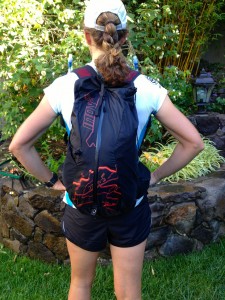
Somehow, I need to fit a sleeping bag and pad, a few pieces of clothing, some safety gear and enough food for seven days into this thing.
But once I started running and tried numerous adjustments of the straps, I warmed up to this system and am cautiously optimistic it’ll work well. The sloshing and jiggling of bottles on the front straps takes getting used to, but having the water in front helps balance the weight of the back.
Other participants in the Grand-to-Grand Ultra recommend another pack system I’d like to try as well: the Salomon XA25 with an optional 5-liter front pocket that attaches on the chest and has bottle holders.
In any event, choosing a pack is only the first step; gradually getting used to running with it takes a period of many weeks. I filled mine about three-quarters full with gallon-sized Ziplocks full of dog kibble for weight. (I heard kitty litter also works well for this purpose, and might be a smarter choice for wilderness training runs where large animals might catch the scent of dog food and want a taste.) I was shocked by how heavy the pack felt—and more shocked when the scale revealed it was only 13 pounds.
Running with the loaded pack slowed my pace by a couple of minutes per mile and put extra strain on my quads and knees going up and down hills. The muscles around my neck and upper back slowly started to ache.
Jen Segger, a professional coach for the Grand-to-Grand Ultra, emphasizes the importance of core and strength training to prepare for pack running, along with squats and lunges. “Focus on developing all the deep internal muscles that stabilize the trunk, including the glutes, pelvic muscles, abs and muscles surrounding the upper and lower spine,” she says. “A strong back is key to keeping your trapezius muscles relaxed and not aggravated.”
I’m going to take her advice and add it to my to-do list, which is shaping up unlike any other from summers past. With less than three months remaining to prepare, I have to work on the following:
* Base training: Increase mileage, which currently averages around 50 miles per week, by 30 to 50 percent (65 to 75 miles per week), emphasizing back-to-back long runs and running-hiking in the mid-afternoon heat.
* Pack training: Start with one pack run weekly and build up. Wear the pack around during the day. Literally run errands.
* Terrain-specific training: Learn to run in the sand wearing full-cover gaiters. Train at altitude as much as possible.
*Strength training: Work out at the gym, with an emphasis on core conditioning, two to three times a week. Stretch, strengthen and ice my injury-prone ankles and feet to keep them from falling apart.
*Gear up: Research and purchase key items such as an ultralight sleeping bag, specific clothing and required safety items. Experiment with taping feet and toes while learning the art and science of blister prevention.
* Nutrition and hydration: Experiment with backpacker-specific dehydrated food and other calorie-dense, easy-to-pack edibles. Experiment on long runs with different high-calorie food and drink mixes. Toward the end of summer, go a week eating only the type of food I plan to eat during the event. Wean myself off alcohol, diet sodas and coffee.
* Other: Rest. Sleep. Mentally prepare. And, of course … express endless gratitude to my family for tolerating my training.
Can I do it? I’m not sure, but at least I’m learning what I need to do to do it, and that’s a start.

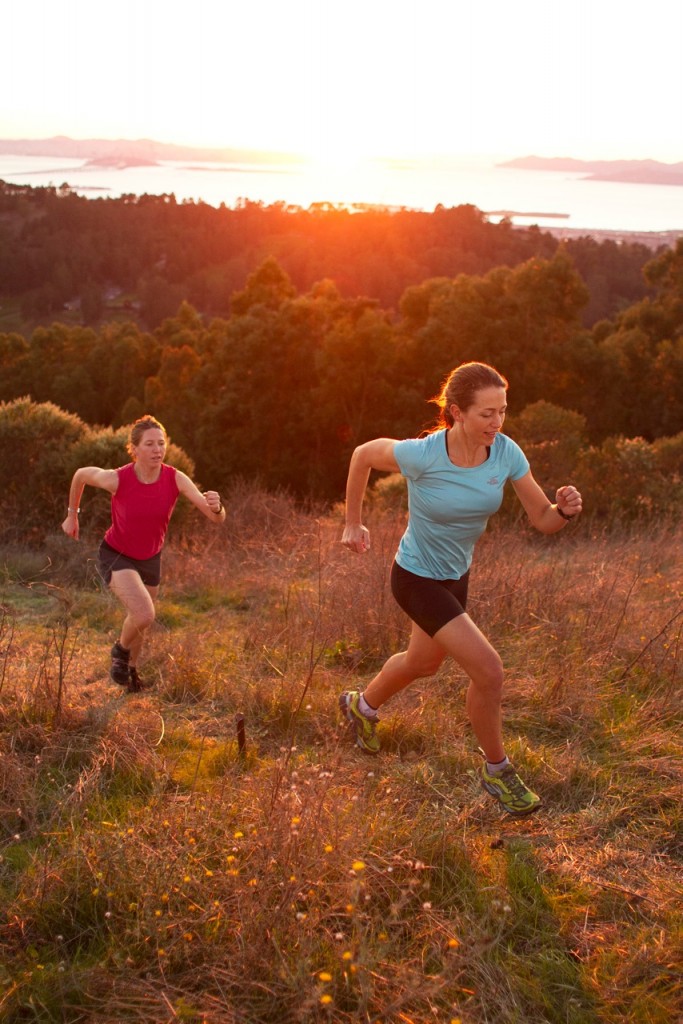
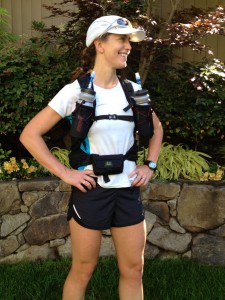
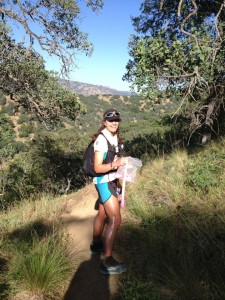
I think you should write a book titled something like “Running and Parenting”… or something to that effect. You’re a great writer, runner, and parent from everything I’ve read. Why not combine it all into one book? I’d like a signed copy, please. =)
Nice post Sarah. I know exactly what you’re going through with the struggle to find balance. I’ve been dealing with an injury since Ohlone and with the N Lake – S Lake loop looming over everything I’m really struggling over whether or not I should just pull the plug.
Toss that in with taking care of my family and work and it’s trying to say the least.
Reading your post helped though.